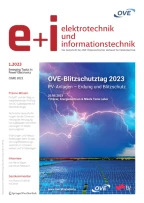Zusammenfassung
Im allgemeinen Maschinenbau kommen zunehmend drehzahlveränderbare Antriebe in Permanentmagnet (PM)-Synchrontechnik zum Einsatz. Werden hohe Anforderungen an die Korrosionsbeständigkeit gestellt, zum Beispiel bei Antrieben in der chemischen Industrie, so kommt als Wellenmaterial oft Duplexstahl zum Einsatz. Aufgrund der magnetischen Eigenschaften eignet sich Duplexstahl aber auch als Läuferaktivteil für PM-Synchronmotoren. Da die Verwendung von Duplexstahl als Aktivteilmaterial wenig bekannt ist, werden zunächst die elektrischen und magnetischen Eigenschaften von Duplexstahl auf der Basis von Prüfkörpermessungen vorgestellt. Die relativ geringe Permeabilität von Duplexstahl erfordert einen höherpoligen Motorentwurf, was die Ständerausführung in Zahnspulentechnik begünstigt. Ein Funktionsmuster in Duplexstahl-Technik wird beschrieben, und das stationäre Betriebsverhalten des Funktionsmusters wird im direkten Vergleich von Finite-Elemente-Methode (FEM)-Simulation und experimenteller Erprobung diskutiert.
Abstract
An increasing transition to variable speed drives in permanent magnet (PM) synchronous technology is a constant trend in mechanical engineering. If there are high demands regarding corrosion resistance, for example in the chemical industry, duplex-steel is a suitable material for the rotor shaft. Because of the ferromagnetic characteristics, duplex-steel is an ideal material for rotor bodies of PM synchronous machines. Because rotor designs in duplex-steel technique are unusual, the electrical and magnetic qualities of duplex-steel will be introduced, initially. In comparison to other ferromagnetic materials, the permeability of duplex-steel is very small. Therefore, the layout process leads to a higher number of pole pairs and that favors a stator design in tooth-coil technique. The draft of a sample motor in duplex-steel technique is represented and, finally, the steady-state behaviour of the sample motor is discussed in direct comparison to finite-elements method (FEM) simulations and measurements.
Literatur
KSB AG (2015): Spaltrohrmotorpumpen-Baureihenheft „Ecochem Non-Seal“, 29.05.2015.
DIN EN 10027-2:2015-07 (2015): Bezeichnungssysteme für Stähle.
IMA (2014): Practical guidelines for the fabrication of duplex stainless steels. 3. Aufl. International Molybdenum Association. ISBN 978-1-907470-09-7.
DIN EN 60404-2:1998 (1998): Magnetische Werkstoffe, Teil 2: Verfahren zur Bestimmung der magnetischen Eigenschaften von Elektroband und Elektroblech
DIN EN 60404-6:2003 (2003): Magnetische Werkstoffe,Teil 6: Verfahren zur Messung der magnetischen Eigenschaften weichmagnetischer und pulverförmiger Werkstoffe mit Hilfe von Ringproben
Huth, G. (2005): Permanent-magnet excited ac servo-motors in tooth-coil technology. IEEE Trans. Energy Convers., 20(2), 300–307.
Ishak, D., Zhu, Z., Howe, D. (2006): Comparison of PM brushless motors having either all teeth or alternate teeth wound. IEEE Trans. Energy Convers., 21(1), 95–103.
Patentschriften DE102007028356/EP2156534.
Huth, G. (1999): Optimierung des Wicklungssystems bei permanentmagneterregten AC-Servomotoren. Arch. Elektrotech., 81, 375–383.
Magnussen, F., Lendenmann, H. (2007): Parasitic effects in PM machines with concentrated windings. IEEE Trans. Ind. Appl., 43(5), 1223–1232.
IEC 60034-30-1.
Author information
Authors and Affiliations
Corresponding author
Rights and permissions
About this article
Cite this article
Löhlein, B., Huth, G. Permanentmagnet-Synchronmotoren in Duplexstahl-Technik. Elektrotech. Inftech. 133, 82–87 (2016). https://doi.org/10.1007/s00502-016-0391-0
Received:
Accepted:
Published:
Issue Date:
DOI: https://doi.org/10.1007/s00502-016-0391-0
